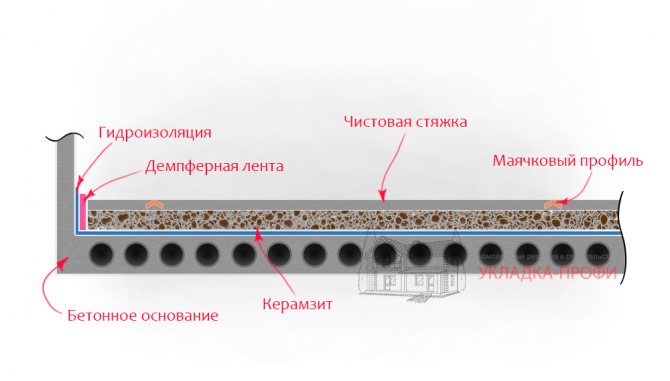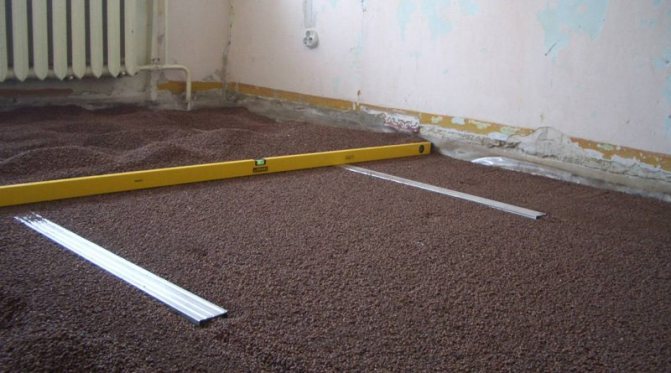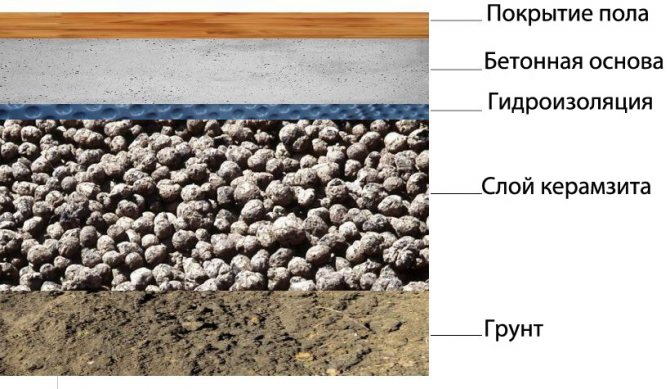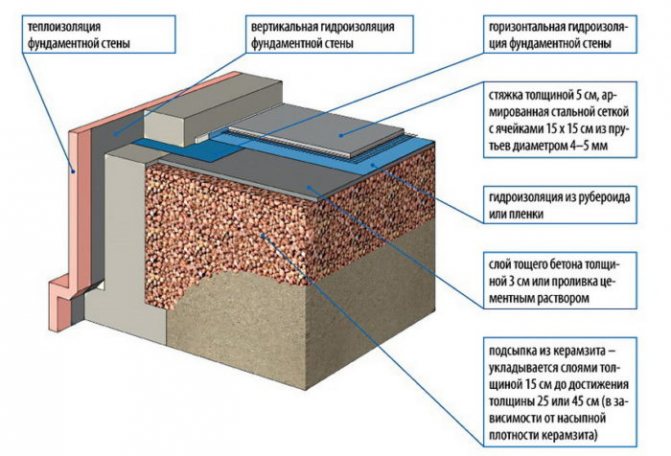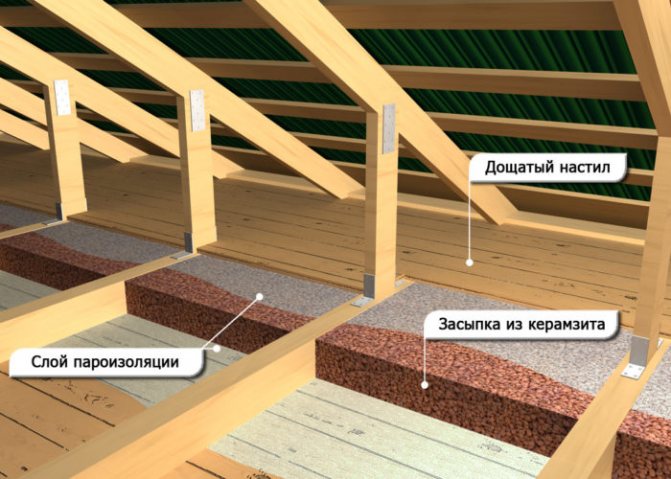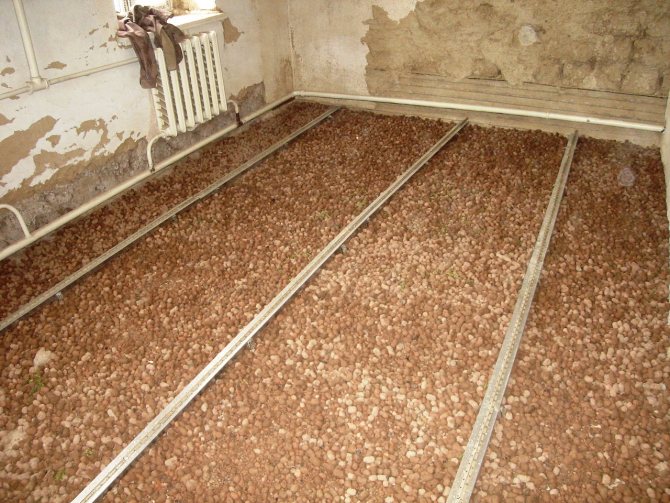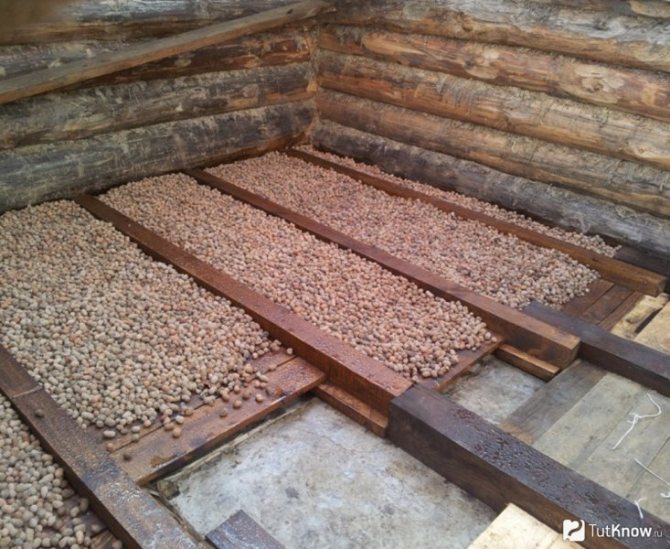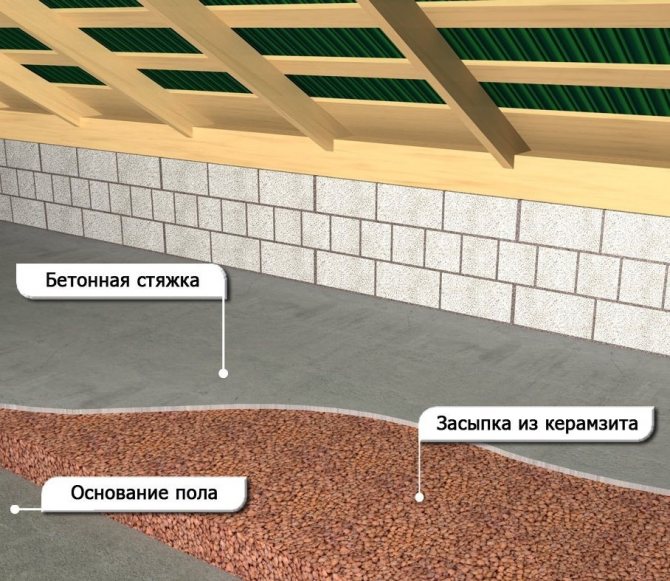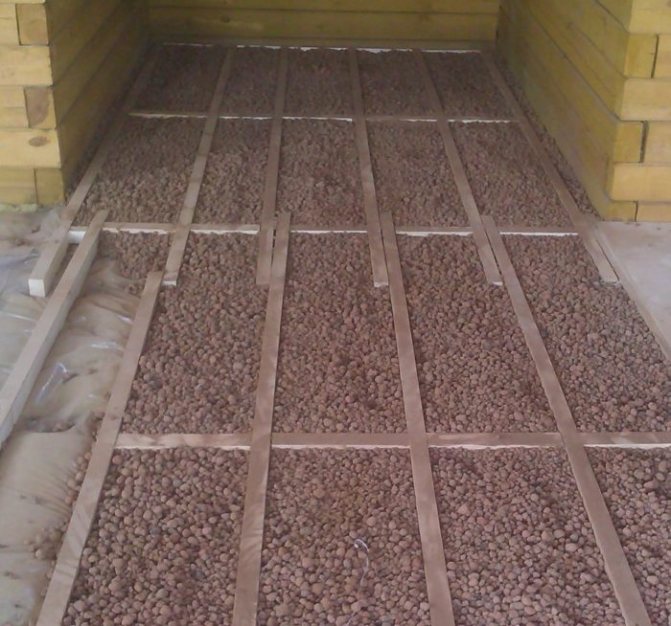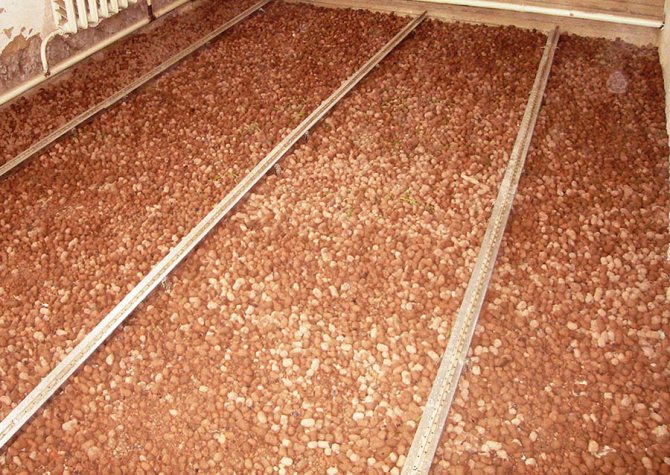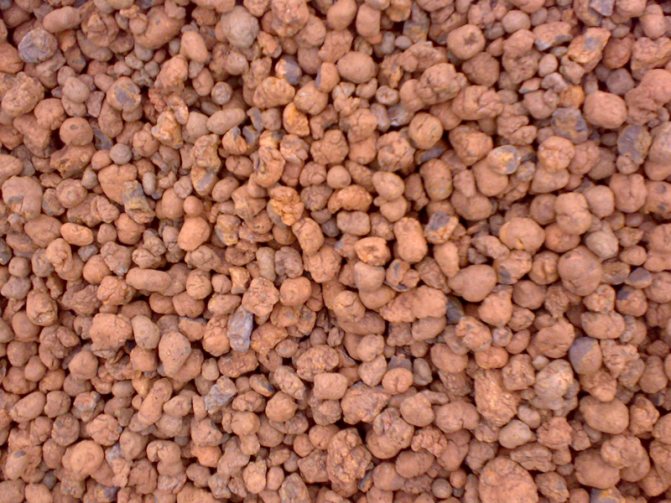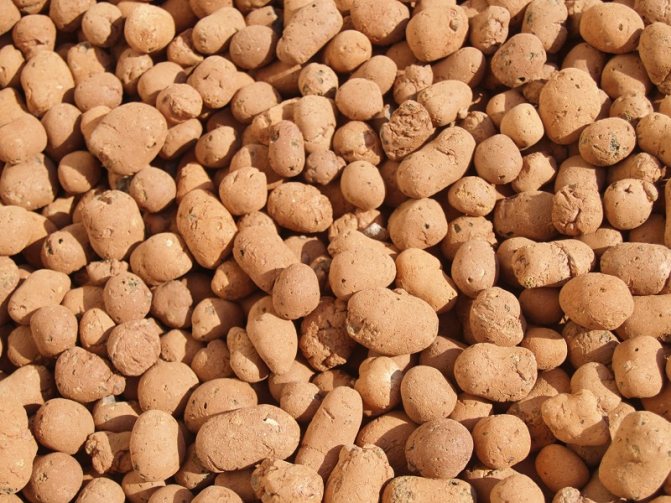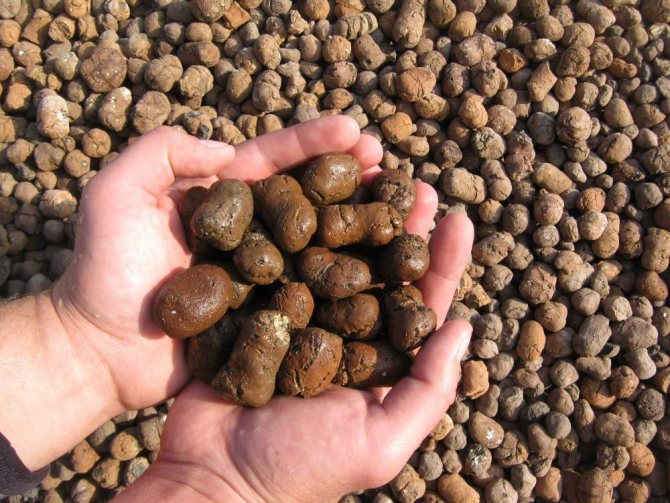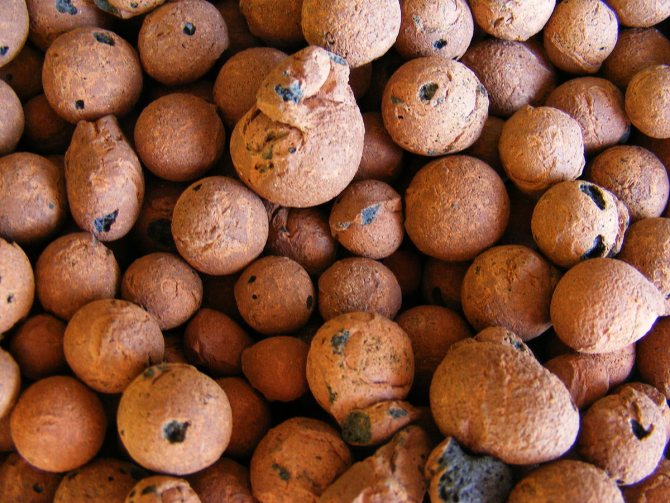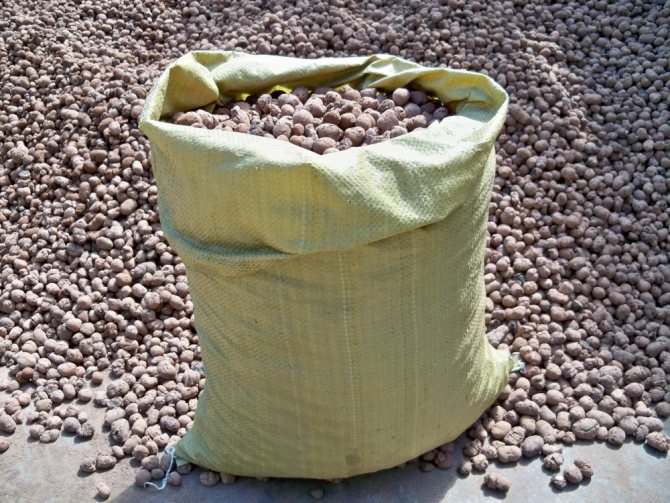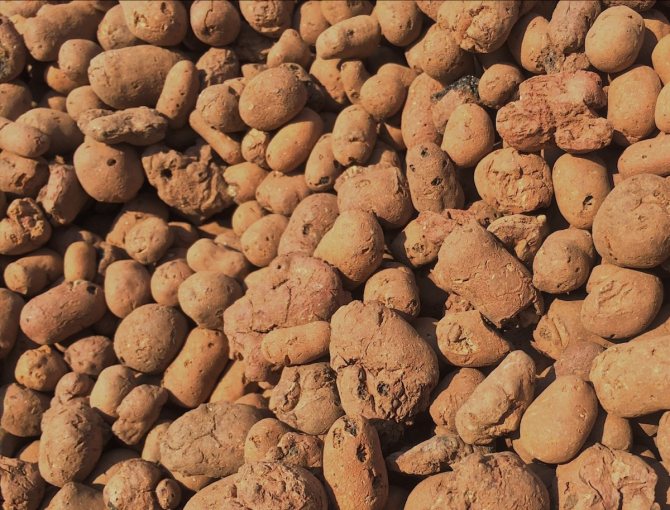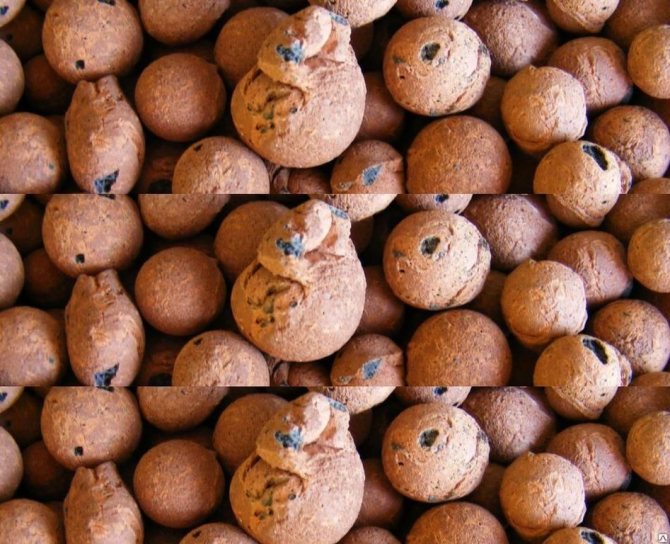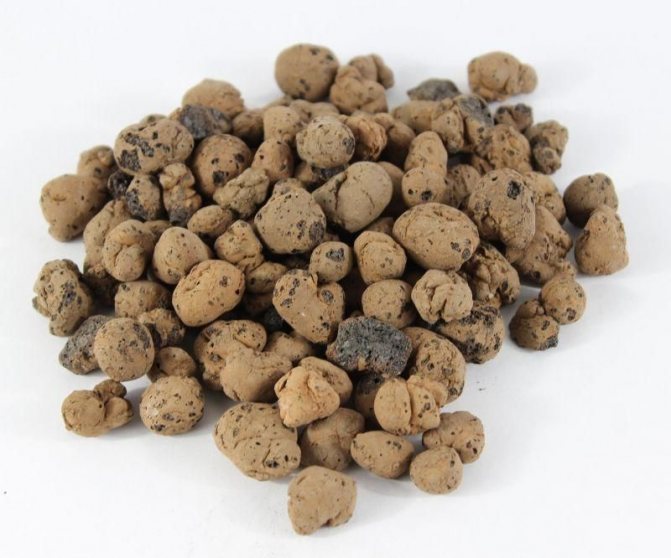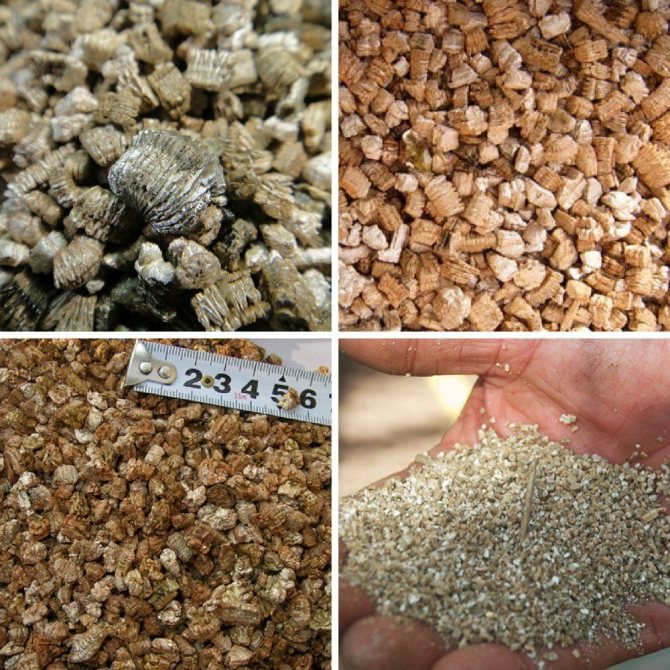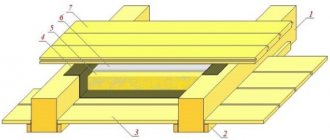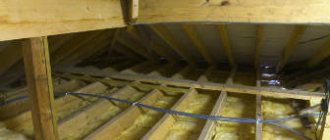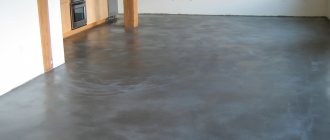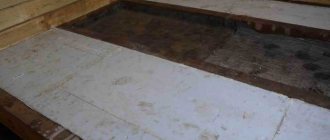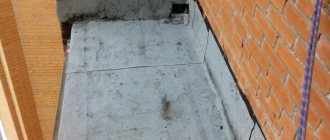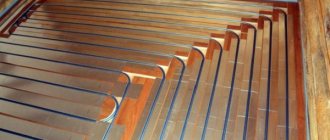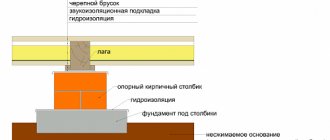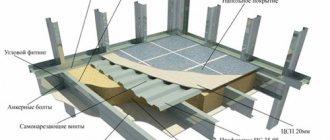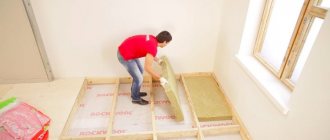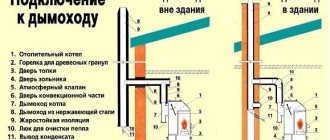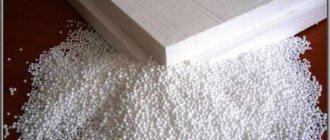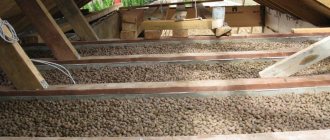Floor insulation technology using expanded clay
Korovin Sergey Dmitrievich
Master of Architecture, graduated from the Samara State University of Architecture and Civil Engineering. 11 years of experience in design and construction.
Anyone with a construction education is familiar with heat engineering. This is a whole science that studies the protection of buildings from the penetration of cold and is based on the laws of physics. With the help of calculations, experts find out the thickness of the insulation, selected from a huge range of modern materials. It is important to protect all structures from the cold: walls, floors, roofs. Warming the floor with expanded clay can be one of the options.
How insulation works and why is it needed
Air is the most effective thermal insulation material. Only inert gases, which practically do not react with the environment, can compete with it. Such gases are used, for example, when filling the chambers of double-glazed windows, but it is impossible to ensure complete tightness in the main building structures.
All thermal insulation materials have a porous structure. It is in the pores that air is retained and prevents heat loss. The lower the density of the material, the better it will perform its function. Insulation can be used roll, plate, spray or bulk. Bulk is one of the most budgetary and easy to do-it-yourself laying, but it also has the lowest heat-shielding characteristics.
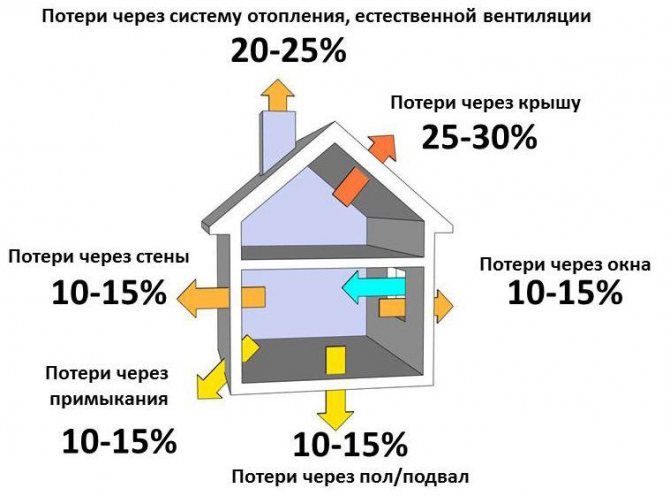
The main heat loss at home. Through the floor - 10-15%.
It is necessary to insulate the floors above the basement, on the ground or in the ceiling of a cold attic for the following reasons:
- ensuring a comfortable stay in the house;
- reduced heating costs;
- protection of structures from condensation, which leads to the formation of mold and mildew;
- increasing noise insulation.
If you do not carry out the insulation, serious problems will arise during the operation of the house.
Pros and cons of expanded clay as insulation
During the construction of apartment buildings, the thermal calculations of the building structures, along with the strength calculations, are checked by an examination. In this case, floor insulation with expanded clay is not used, since this material cannot be classified as highly effective. It is most profitable to lay bulk insulation in a private house.
Its advantages include:
- ease of styling with your own hands;
- low cost;
- environmental Safety;
- creating an even base for the floor cake;
- resistance to temperature extremes;
- the possibility of using for floor insulation, which in the future will be subjected to heavy loads, for example, the floors of industrial facilities.
The negative characteristics include the fact that this material has a lower thermal insulation capacity compared to mineral wool and expanded polystyrene.
Before insulating the floor with expanded clay, it is necessary to determine which layer of thickness will be used. Bulk material has twice as much thermal conductivity as mineral wool, so its thickness should be doubled. In most cases, the best option would be 200 mm.
Faction selection
Expanded clay is made from special clay, which swells when heated. It is represented by three factions:
- Expanded clay sand. It is added to dry mixes to improve their thermal insulation characteristics;
- Expanded clay crushed stone. It is a larger particle with sharp edges;
- Expanded clay gravel. It is the best material for insulation in a private house. It has the same size as crushed stone, but in a rounded shape.The pores are protected from the outside by a layer of caked clay.
It is recommended to purchase expanded clay with granules of different sizes, as this will ensure its penetration into all hard-to-reach places.
It is important to ensure that there is a minimum amount of damaged granules in the total volume, in which case the insulation will become most effective.
Application area
There are a lot of options for using the material when insulating floors in the house:
- insulation of floors on the ground under the screed;
- backfilling the space under the boardwalk when arranging floors along the logs;
- insulation of the attic floor.
It is important to remember that in all three cases, the floor cake is quite different. Insulation of the attic with expanded clay depends on the design of the floor, it can be performed both along the logs and under the screed.
Material characteristics
Expanded clay production technology consists in firing formed granules from previously prepared clay. It is dried and cleaned, and then grinded. Insulation is produced only from such high-quality raw materials.
An important point in the production process is the coincidence of active gas separation in clay with the time of its transition to a pyroplastic state, since swelling occurs at this time, which guarantees lightness and low heat conductivity after solidification of the granules.
This whole procedure takes place at an optimal temperature that exceeds 1100 degrees.
The entire manufacturing process is carried out in a rotary kiln, into which raw blanks fall, and finished insulation granules come out. They have a melted, durable and sealed shell that is resistant to external factors.
Expanded clay properties
Expanded clay is made on the basis of natural materials, therefore it is an environmentally friendly product. Its strength and durability is several times higher than the quality of synthetic insulation.
It is not subject to decay processes, the influence of temperature changes, it calmly tolerates severe frosts and heat, and expanded clay is moisture resistant.
With such properties, it may well be considered a versatile material suitable for insulating floors, walls and attics.
Expanded clay granules vary in size from 3 to 45 mm.
Due to the naturalness of the material and production technology, it is fire-resistant and does not emit harmful fumes under any circumstances.
The composite has undeniable useful qualities that are especially important for residential premises:
- thermal insulation and sound insulation;
- acid resistance and chemical inertness.
In addition, it should be noted that with the high quality of this composite material, it has a very affordable price.
Varieties of material
Expanded clay is divided into three types or fractions: sand, gravel and crushed stone.
Each one is good for a specific warming process and comes in a specific size.
- Crushed stone is small stones, ranging in size from 5 to 45 mm, with sharp corners.
- Expanded clay sand, obtained by crushing larger parts, has a size from 0 to 5 mm.
- But the most popular and often used fraction is gravel, which is used for insulation in the form of dry backfill or by adding it to a cement-sand mortar to create slabs.
Attics are often insulated with gravel, as it is lightweight, unlike sand and gravel. It is also good for insulating floors, especially private ones. Surprisingly, it is a fact - mice never get out of it in the layers.
It should be noted that a ten-centimeter layer of expanded clay gravel in terms of insulating qualities surpasses a meter-long brickwork, a 25-centimeter wooden interlayer or a half-meter thick claydite concrete slab.
Bulk density
The quality of the insulation is determined by the grade of the source material and compliance with the technology. The brand of bulk density depends on them:
- М 250 - bulk density 250 kg per m3;
- М 300 - from 250 to 300 kg per m3;
- М 350 - from 300 to 350 kg per m3;
- М 450 - from 350 to 450 kg per m3;
- then there are brands from M 500 to M 1000, weight, each of them per m3 increases by 100 kg.
Bulk density grade is set by GOST-9757-90.
Insulation technology
In order to competently carry out measures to improve the heat-shielding characteristics of the floor with your own hands, you must follow the order of work. Depending on the type of floor to be insulated in the house, the layers and their arrangement differ.
Floor on the ground
The work is carried out in the following order:
- compaction and leveling of the base;
- adding sand and gravel for additional compaction and leveling;
- laying of waterproofing material (in the case of a high level of groundwater);
- laying and leveling a layer of expanded clay;
- Lean concrete footing device;
- laying of a vapor-waterproofing material, which can be used as an ordinary plastic film;
After performing insulation on the ground, a reinforced cement-sand screed is poured with their own hands, on top of which a clean floor covering is laid.
Insulation of the basement or underground floor
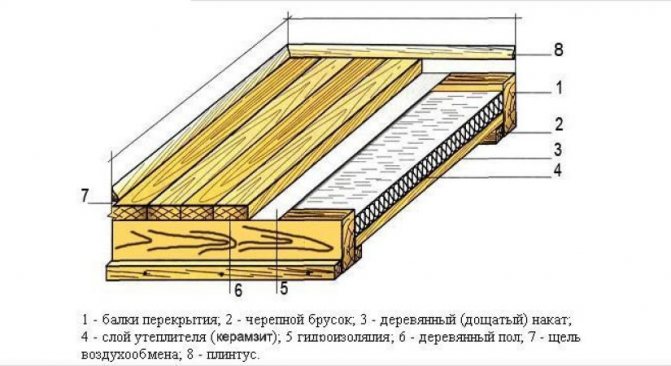

Warming of a wooden floor with expanded clay can be done both on logs and without them. It is necessary to lay each layer in the order presented:
- floor installation;
- laying a layer of waterproofing;
- if necessary - installation and fixing of the lag;
- bulk material is laid;
- leveling expanded clay;
- vapor barrier layer - polyethylene film;
- installation of a clean floor or screed.
It is very important when working with insulation to lay the waterproofing and vapor barrier in the correct order.
Insulation of the attic floor
For the attic, each layer is arranged in a slightly different order:
- floor structure;
- vapor barrier - polyethylene film;
- when laying insulation on logs - installation of wooden bars;
- backfilling of expanded clay;
- waterproofing;
- clean floor or cement screed.
Comparison of varieties
Technologists conducted an experiment. During the study, we used expanded clay backfill and natural material. The results showed that expanded clay is not suitable for the role of a base under the floor, since it does not meet the required standards and parameters.
The advantages of dry backfill include factors such as the possible height of the coating up to 2 cm, which provides protection against subsidence. The material consumption is small, 10 kg of backfill will be required per 1 square meter, provided the layer thickness is 1 cm.
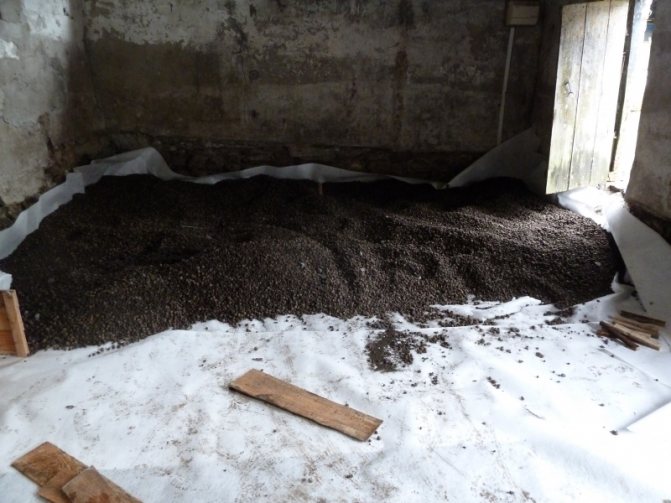

A sufficiently high bulk density of expanded clay backfill for Knauf floor minimizes the risks of deformation of the main coating. Also protects against moisture condensation and provides good sound insulation. The material is strong enough to make a dry floor screed. As for expanded clay, it is used less and less, since it does not guarantee the same level of endurance and strength as backfill.
Features of laying expanded clay
When carrying out activities for the heat protection of the floor with your own hands, it is necessary to take into account the peculiarities of the material used. Carrying out floor insulation with expanded clay, you need to know:
- To obtain a flat surface, beacons are used. The smaller the step of mounting the lighthouses, the more chances you have to perfectly lay expanded clay with your own hands.
- When laying on logs, all wooden elements must be treated with antiseptic compounds.
- The minimum layer of material is 10 cm.
- It is best to install a wooden floor covering when using expanded clay.
- The floor can be used 7 days after the completion of construction or repair work.
Screed laying technology on expanded clay:
Do-it-yourself insulation with expanded clay allows you to carry out work with minimal costs without compromising quality.
A Few Tips
In order to qualitatively perform floor insulation using expanded clay, it is necessary to follow a number of specialist recommendations. Here is some of them:
- To calculate the exact amount of expanded clay, you should determine the floor load.
- The waterproofing film is laid in such a way that its extreme part is wrapped on the walls.
- If it is not possible to purchase T-shaped beacons, then old pipes or a corner can be used instead. The main thing is that they are even.
- The fastest solidification of the exposed lighthouses is achieved with the help of alabaster.
- You can not do expanded clay backfill until the solution under the beacons is completely seized.
- After filling the first layer of expanded clay, it should be covered with cement milk.
- Warming of a wooden floor is carried out by mixing 2-3 fractions of expanded clay.
- The setting process of expanded clay screed is checked using a glass jar. At night, they put it on the screed with the neck down. If the can is covered with condensation, the floor must still dry.
Video about the device of floors with expanded clay:
Thickness calculation
In all these cases, when filling, the thickness is selected approximately, the layer is taken 15-20 cm. But if necessary, you can carry out a simple calculation. In this case, specialists use the Teremok program. It is very simple and freely available. You can calculate the layer online or offline by installing the software on your computer.
Bulk insulation is available in the database, you just need to find it. For building a house with your own hands, this program will be able to make professional heat engineering calculations for any floor structure: on the ground, on the ground floor, in the attic.
What is expanded clay
Expanded clay is a loose insulation consisting of granules of different sizes. It is made from low-melting types of clay by the fast firing method. The result is a material with a porous surface, which provides good thermal insulation properties. It is highly durable and lightweight. For construction work, expanded clay of three fractions is used, information about them is presented in the table.
| Expanded clay fraction | Density tons / cubic meter m | Weight 1 cub. m |
| Sand fraction 5-10 | 0,45 | 0,45 |
| Gravel fraction 10-20 | 0,4 | 0,4 |
| Crushed stone fraction 20-40 | 0,35 | 0,35 |
The operational properties of all fractions are approximately the same, each is used where it is more convenient. For example, gravel and crushed stone are usually chosen for floor insulation.
Material advantages
Expanded clay is a free-flowing granular material made from fired clay. For the implementation of thermal insulation work, this material has been used for a long time.
Despite the appearance of many new materials, expanded clay has not lost its popularity today. This is due to the excellent technical characteristics of the material:
- light weight;
- unpretentiousness in work;
- resistance to temperature extremes;
- ecological cleanliness;
- absolute fire safety;
- ease of installation work;
- excellent sound insulation properties;
- reasonable price.
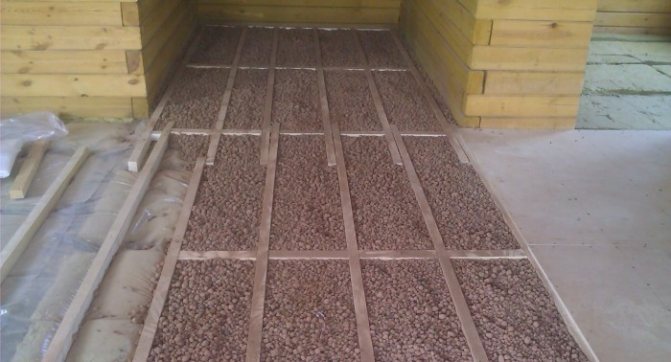

The quality of expanded clay for the floor directly depends on the correct observance of the technological process in the manufacture of the material. Expanded clay is obtained as a result of the impact on the clay of a sharp thermal shock. Low-melting clay swells and becomes covered with pores. The top of the pellets is exposed to high temperatures, resulting in a hermetically sealed material.
Depending on the diameter, there are the following expanded clay fractions:
- 5-40 mm;
- 40-50 mm;
- over 50 mm.
Methods for insulating the floor with expanded clay
One of three possible methods can be chosen for arranging thermal insulation of floors. Let's consider each of them in more detail.
Dry laying of expanded clay
The fastest and least time consuming option. It involves backfilling expanded clay on the base under the subfloor.The insulation can be laid loose throughout the room, but in this case it will be quite difficult to align it. Therefore, logs or beacons are installed on the base and expanded clay is poured between them. A sub-floor is laid on top of the insulator layer, which must be at least 10 cm. Already, the topcoat is being mounted on it.
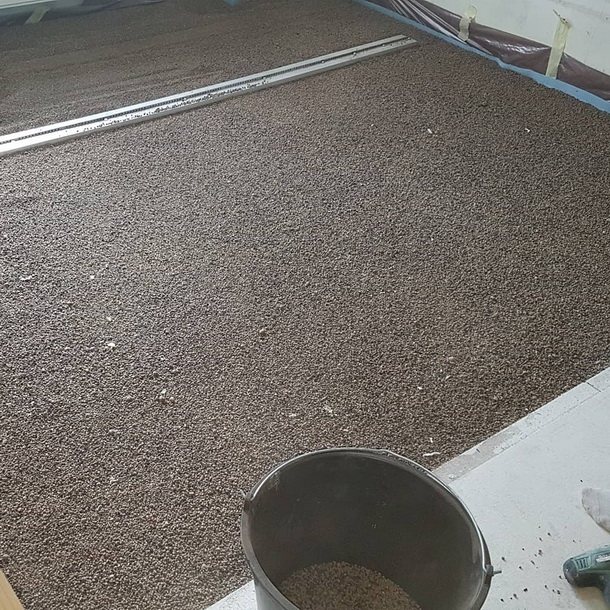

Photo: Instagram brigadaspb
Stages of work:
- Preparing the base. If necessary, we dismantle the old floor covering. We clean, remove debris and dust. We close up large defects and cracks, joints between the walls and the floor.
- Install lags. If the old ones have survived, we carefully inspect them, remove the unusable ones. We set the beams exactly on the level, so that their upper edges form a flat surface.
- We install waterproofing. We lay the membrane or ordinary polyethylene in such a way that they cover the logs. We overlap the resulting joints and glue with special tape. We fix the material on the logs with a stapler.
- We mix expanded clay of two fractions to make the coating more dense. We fill up the space between the lags with the resulting mixture. We tamp the granules and level the backfill layer.
- We lay the top layer of waterproofing, attach it to the logs.
Now you can lay the subfloor and proceed with the installation of any topcoat.
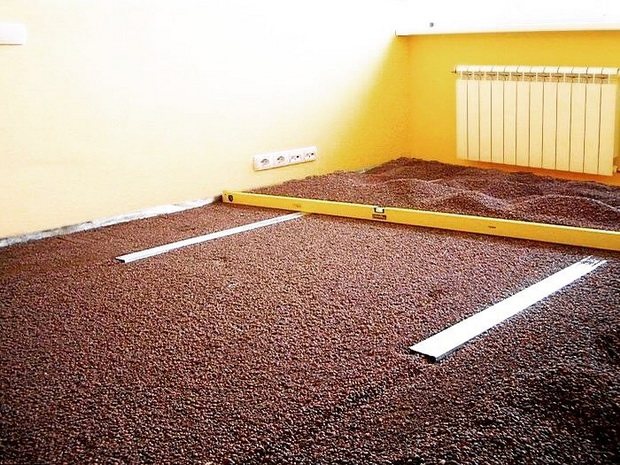

Photo: Instagram sk_tehnologiya
Wet laying of expanded clay
It involves mixing expanded clay with liquid concrete. The resulting mixture is placed on beacons similar to a conventional screed. This method is especially good for foundations with significant elevation differences. The main disadvantage is a decrease in the insulating properties of expanded clay in concrete.
Stages of work:
- We prepare the base, freeing it from debris and dust. We repair defects if necessary.
- We set beacons strictly according to the level. The operation is carried out in the same way as when laying a conventional leveling screed.
- Mix in portions expanded clay with a cement-sand mixture. There are no exact proportions, approximately 1 part of the filler is taken for 2 parts of the solution. The main criterion is that all granules must be wetted with liquid concrete.
- We spread the resulting mixture between the beacons using a trowel. We immediately level the upper part with a long rule.
The expanded clay concrete screed will dry out in two days, but it will be possible to lay the topcoat on it not earlier than in a month.
Combined method of warming with expanded clay
The insulation is poured between the logs and leveled. Then the top layer of the material is fixed by spilling it with cement mortar. The concrete screed is poured after the prepared base is completely dry. The advantage of this method is to preserve the insulating properties of expanded clay. The material can be laid directly on the ground, for example in a country house, or on a concrete base.
Stages of work:
- Preparing the base. We carry out, if required, dismantle the old coating, remove debris, seal up defects and cracks.
- We lay the waterproofing under the insulation. This can be a membrane or a film or a layer of liquid insulation. In any case, the material should cover not only the floor, but also the lower part of the walls like a "box". After that, at the level of the future screed, we fix the damper tape.
- We expose metal beacons. Aluminum T-bars are ideal. We put them strictly according to the level, fixing them to the solution.
- We mix expanded clay of two fractions for better filling density. We fill the space between the beacons with this mixture, paying special attention to the joints and corners. Gently ram the granules, maximally compacting the insulation layer.
- We carry out reinforcement. We lay a coarse-mesh metal mesh over the expanded clay. It should be free of dents and sharp edges.
- We lay the screed directly on top of the expanded clay.We apply a sand-cement mixture, level it with a long rule.
After the mortar has completely dried, it will be possible to lay the topcoat.
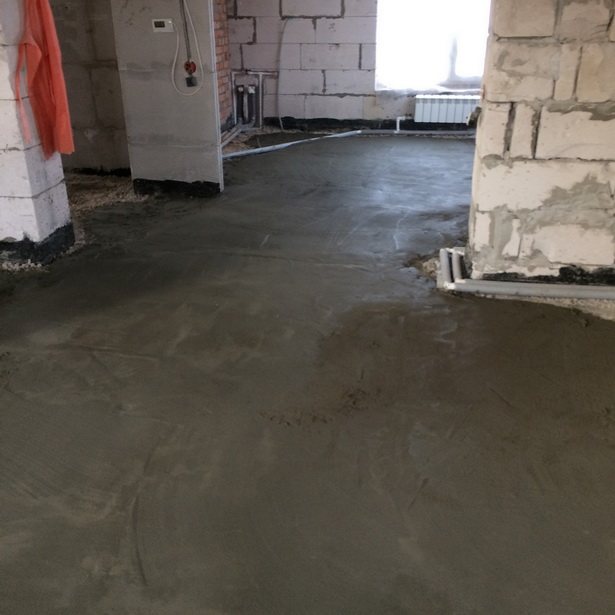

Photo: Instagram pravremont.ru
The use of any of the described methods of floor insulation with expanded clay, provided that it is performed correctly, guarantees effective protection from the cold.
- Prepared by: Inna Yasinovskaya
No comments yet. Start a discussion!
IVD. 2-room apartments
Found a bug? Select it and press Ctrl + Enter
The IVD.ru website is a leading Internet project dedicated to the reconstruction and interior design of residential premises. The main content of the site is the archive of the Ideas for Your Home magazine - exclusive author's articles, high-quality illustrations, practical advice and lessons. A team of professionals is working on the project in close cooperation with renowned designers, architects and leading experts of the publishing house.
On our site you can find complex design solutions; view detailed reviews of the market for building and finishing materials, furniture, machinery and equipment; compare your own ideas with the design projects of leading architects; communicate directly with other readers and editors on the forum.
Thermal insulation of wood floors
Further, the process of insulating a wooden floor on a concrete base will be considered in more detail, which must be carried out in the following sequence:
- Removing the floor covering. The floorboards must be removed and taken out of the room, and then a thorough inspection and check the joists with the building level. If the wood elements are in excellent condition, without deflections and other defects, then they can be left in the same place. For minor damage, only the required lags should be replaced. If they are too old, poorly fixed, or have begun to rot, then each of them must be removed right down to the concrete base.
- Surface preparation. The first step is to clean the floor of debris, repair minor cracks, and inspect the corners. The deep damages revealed in these places must be covered with mortar or filled with polyurethane foam, which should also be used to process the joints around the perimeter of the walls and the base of the floor covering. Next, the surface must be filled with a layer of sand and fully compacted. If coating waterproofing is used, then there is no need to use sand.
- Waterproofing. At this stage, it is required to spread polyethylene or a special membrane on the floor in such a way that the edges of the material extend beyond the boundaries of the walls along the perimeter by 8-10 cm. In this case, the logs also end up under the film. If a single piece is not enough, then the strips from it should be overlapped and the joints should be fixed with construction tape. On the bars, the waterproofing must be fixed with a stapler, by distributing the polyethylene in the grooves between the lags. When using waterproofing mastic with the composition, it is necessary to open the concrete base, free of dust, using a roller or a paint brush, capturing the surface of the walls to a height of 15-20 cm.In this situation, the installation of the lag is required to be done above the protective coating. As a mixture, you can use mastics on a bitumen or cement-polymer base, liquid rubber, as well as bitumen-polymer compositions. It is necessary to apply the mixture in 2-3 layers, each of which is fully absorbed in about 3 hours. At the end of the stage along the length of all walls at the height of the rough floor covering, it is necessary to fix the damper tape, which will eliminate deformation and the appearance of cracks on the screed during temperature drops.
- Installation of rails. In case of complete deformation of the lag, it will be necessary to replace them.To do this, you need to take strong slats or beams made of wood, cut them to the required size in accordance with the length of the floor, open it with an antiseptic and wait for it to be fully absorbed. The height of the timber frame for the flooring must be at least 10 cm. The last logs must be placed and installed at a distance of 2-3 cm from the walls. Between the rest, you need to maintain a distance of 50-100 cm. Optimally 0.5-0.6 m. Each lag must be placed using a building level and parallel to the others so that none of them is above or below the horizontal plane. The beams must be fixed to the base of the floor with screws by means of metal corner plates. One side of them is adjacent to the wood, and the other to the floor covering, on which the logs are laid. The last fasteners should be fastened 2-3 cm from the edges of the rails, and all others, subject to a distance of about 50 cm.
Note! In addition, dowels, anchors and other similar products can be used as fasteners, which, when properly installed, provide no less reliable fixation of the lag than metal corners.
- Falling asleep of expanded clay. Initially, you need to mix the expanded clay of small and large fractions with each other, and then fill all the free space in the gap in the middle of the lag or guide rails with it.

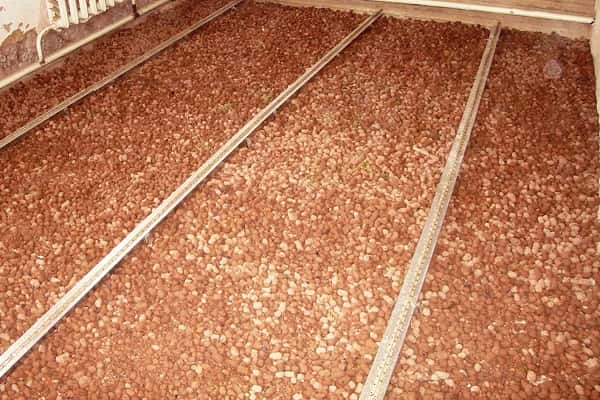
In the corners, the insulation material must be carefully straightened by hand to exclude the presence of voids. Upon completion of filling the entire space, you should carefully tamp the expanded clay layer, trying to avoid damage to the granules. Over the material, it is also required to perform a waterproofing flooring, for fixing which you need to use a stapler. - Laying the floor covering. On the logs peeking out of expanded clay, it is necessary to stuff a rough floor covering from plywood, chipboard or wooden floorboards, after which you can start laying the finishing floor.
At the end, the film protruding along the length of the room should be cut with a knife, and the joints should be hidden with a plinth.
Expanded clay as floor insulation: pros and cons
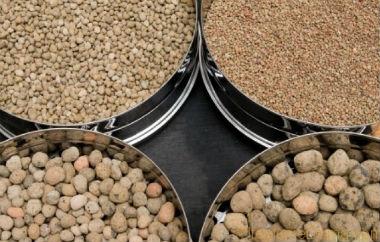

Expanded clay fractions are different (from sand to crushed stone).
The technique of floor insulation with expanded clay in a wooden house, as well as under a screed on a concrete floor, has been used for a long time. It cannot be said that this is the most effective heat-insulating material, since its characteristics are rather modest:
- lambda thermal conductivity 0.1-0.18 W / m * K;
- water absorption 8-10%;
- density up to 500 kg / m. cube;
- does not burn;
- does not contain any harmful substances, all natural.
Despite this, expanded clay as a floor insulation is a perfectly acceptable alternative, given its low price. This is foamed and baked clay, which comes in different fractions: from sand to crushed stone. Compressive strength depends on the density of the material, the higher the density, the stronger the material. For insulation of the floor with expanded clay, according to reviews, thermal insulation of the middle fraction (balls with a diameter of about 1 cm) is most suitable. Despite the low degree of moisture absorption, this material, although slowly, saturates water, after which it does not remove it. It is difficult to dry expanded clay, this process takes a very long time. During installation, dust may appear - these are small chipped particles of baked clay.
Today, gas heating of a private house is cheaper than any other energy source.
Read more about gas heating in the apartment (reviews and opinions) here.
Backfill features
Although precast floor technology is just beginning to rise to its peak, the base material has been around for a long time. You can buy it both on the official websites of manufacturers, and in hardware stores. Expanded clay backfill has the composition of a granular mixture, which speeds up the process of use.
This also provides a secure floor base without the possibility of sagging. Sometimes expanded clay is used instead of granulate, but its parameters are much larger, which creates additional difficulties in the process of placing the floor covering. In addition, the gaps between the material elements complicate the installation process.
After the dust has settled and layers of sand are applied to the substrate, serious deformation of the surface is possible. The developers of the expanded clay backfill took this into account and made all the granules of the same size. This makes the shape and density of the material well suited for this type of work.
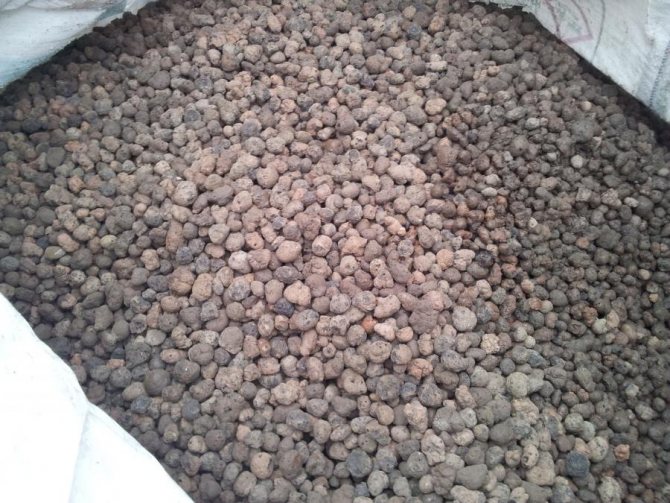

Thermal insulation of wooden floor with expanded clay
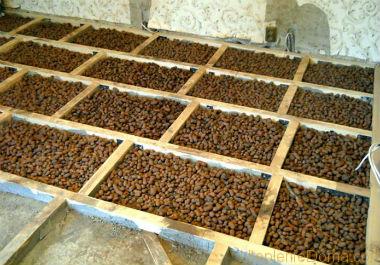

The method of laying expanded clay on the logs (do not forget to lay the waterproofing).
Thermal insulation of the floor with expanded clay in a private house is preceded by the calculation of the required thickness of the thermal insulation cake. At the same time, it will not work to fill in more material than the distance between the rough and final floor. If this distance is not enough, you need to choose another insulation, or somehow increase the buffer zone.
Before insulating the floor with expanded clay, you need to lay waterproofing on the subfloor - this is a diffusion membrane that allows air and steam to pass through only in one direction. The membrane should be placed with the advertisement facing down and the rough side facing the thermal insulation. Laying is carried out with an overlap, there is a special line on the rolls, then all joints are glued. The main task is to prevent moisture from the ground from getting into the thermal insulation layer.
In addition, the insulation must be protected from steam that comes from the room. This is especially true when insulating the floor in a bath with expanded clay. For protection, a vapor barrier film is used - it is a polymer material or reflective insulation that does not allow steam and water to pass through, and foil materials also emit infrared radiation. Therefore, reflective insulation must be installed with the mirror side inward. The vapor barrier is completely sealed. Bottom layers:
- rough floor;
- diffusion membrane;
- expanded clay;
- vapor barrier;
- air gap (desirable);
- clean floor.
In addition to protecting the insulation from moisture, films have another function. Thanks to them, a layer is created in which the air is in a state of relative rest, that is, it does not move. This somewhat reduces the coefficient of thermal conductivity of the enclosing structure, since air (more precisely, vacuum) is the best insulation. Naturally, there is no question of any vacuum in the heat-insulating cake, but, nevertheless, the absence of convection has a positive effect on the quality of insulation.
Having installed a smart home system, heating and all appliances powered by electricity can be controlled from a smartphone.
Read here why a two-pipe heating system of a cottage is better than a one-pipe heating system.
Backfill "Compavit". What is it?
"Compavit" is a special type of dry backfill, which is used for the installation of a dry screed using the Knauf technology. Initially, "Compavit" was developed for floor insulation, but when laying on expanded clay GVL it was possible to achieve the maximum horizontal base. System "Compavit" includes expanded clay granules up to 5 mm in size, which are easily distributed over the rough surface.
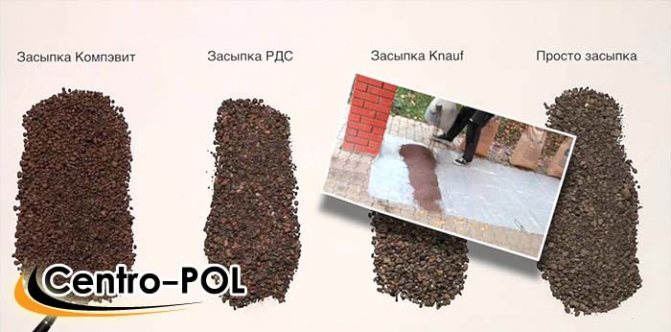

Examples of dry mixes from different manufacturers
When purchasing the Compavit kit, you need to pay attention to the following nuances:
Dry mix for self-leveling floors
- Expanded clay must be finely crushed. If the caliber of granules does not match the value indicated on the package, you should not use such material. After sheathing the rough base of GVL, expanded clay crumbs will shrink, which will lead to deformation of the sheets and the finishing coating;
- Expanded clay should be round.If the granules have an irregular shape (oval, asymmetric), this can affect the degree of shrinkage of the material. Therefore, using a deformed material is fraught with consequences;
- The size of the granules should not exceed 4 mm. Backfills "Compavit" are distinguished by strict observance of the fractional nature of the material. If the discrepancy in linear dimensions between the granules is large, in the future this will lead to deformation of the floor.
Compavit backfill has numerous advantages along with other types of bulk building materials, namely:
- Lightweight expanded clay sand and granules do not create a load on the floors, which is important when repairing floors in apartments;
- The low price for backfill allows the use of high-quality material for processing large-area bases;
- "Compavit" can also be used when arranging a warm floor, since even when heated, expanded clay does not change its properties and dimensions;
- The backfill is suitable for finishing substrates with a high intensity of use (the floor can withstand a load of up to 900 kg per m2).
Adequate price and good quality of bulk material guarantees a long service life of the subfloor and finishing floor.
Warming with expanded clay under the screed
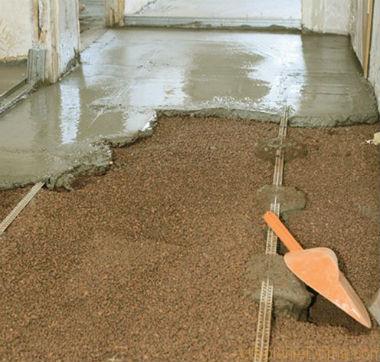

It is necessary to level the expanded clay layer along the beacons for the screed.
Thermal insulation of the floor with expanded clay under the screed can significantly save money, since the modern material that is used for these purposes is expensive. They also read: "Is it worth it to insulate a wooden house with Penoplex". The screed is poured both on a concrete base and directly on the ground. Naturally, floor insulation with expanded clay on the ground is typical for private houses or outbuildings. In apartments, thermal insulation is laid on a concrete base. Let's start with him.
The thickness of expanded clay for floor insulation in an apartment rarely exceeds 5 cm. Of course, the heat-insulating and sound-insulating characteristics of this material are clearly inferior to polymers. Let's make a small calculation, the thermal resistance coefficient of a five centimeter layer of expanded clay will be 0.5 (thickness in meters, divided by thermal conductivity lambda). For comparison, for EPS with the same thickness, the coefficient will be 1.56.
Do not confuse the thermal resistance coefficient of the building envelope with the thermal conductivity coefficient. In the first case, the higher the value, the better the structure retains heat, and in the second case, the higher the value, the better the material conducts heat.
The technique of floor insulation in the apartment with expanded clay under the screed:
- a damper tape is glued around the perimeter;
- polyethylene film is laid;
- expanded clay is poured, then leveled;
- beacons are installed and the screed is poured.
It couldn't be easier. Expanded clay as a floor insulation under the screed on the ground is also used everywhere. First, the soil must be leveled and covered with a layer of sand. The sand is well rammed, roofing material or bitumen roll waterproofing is laid on top of it with launching on the walls at the height of the screed. Damping tape is glued around the perimeter of the room. Expanded clay (10-15 cm) is poured onto the waterproofing and concrete is poured. The method is also quite simple.
Preparation of the base
Regardless of the type of floor insulation with expanded clay (on the ground, under the screed, with a wooden floor), surface preparation is preliminarily carried out. This process consists of three main stages:
- cleaning the sub-floor;
- fixing the elements of communications;
- waterproofing the base.
Cleaning the base
In most cases, at this stage, the old floor is dismantled. Almost all elements are removed, since you need to get to the most durable base.


Using metal scrapers and a brush, the entire subfloor is cleared of dirt and debris. After that, you can walk along the base with a construction vacuum cleaner. Existing cracks are sealed with concrete mortar, polyurethane foam or special glue.
Fixation of communications
To prevent damage to communications, they should be securely fastened. This is done in one of two ways:
- by wrapping the cable and pipes with polyethylene, followed by fixing the communication harnesses to the floor with adhesive tape;
- through the use of metal-plastic sleeves, in which all elements of communication systems are placed.
Base waterproofing
As a waterproofing material, you can use a moisture-resistant mastic or thick plastic wrap.
A roller or a wide paint brush is used to apply the mastic. To obtain the best thermal insulation effect, the surface should be coated with material in 2-3 layers. The drying time of the mastic is within 2.5-3 hours.
If it is decided to use plastic wrap, then it must be laid in strips. Moreover, the strips are overlapped, and their reliable connection occurs with the help of adhesive tape.
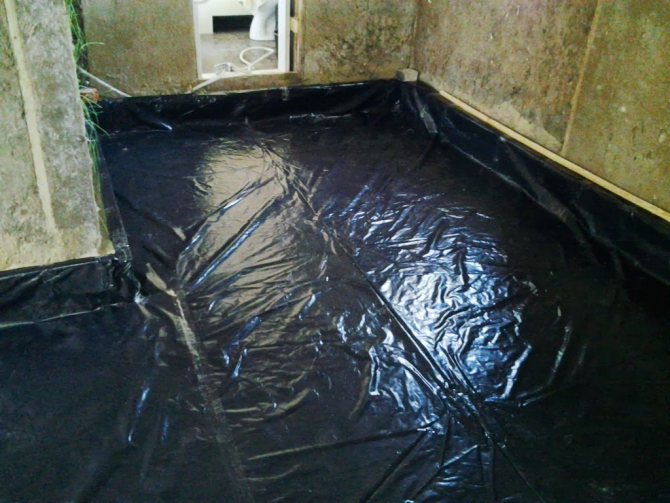

It is also necessary to provide for the walls to be covered with a special waterproofing tape (at a height of about 10-12 cm). Due to this, an even gap is formed between the wall and the screed, which serves to prevent thermal deformations.
How to insulate the floor in a wooden house with expanded clay
Wooden construction is mainly country houses. Moreover, both new buildings and those that were built long ago as summer cottages. Today these buildings are increasingly used for year-round living. Therefore, the issue of warming all parts of the house becomes urgent.
The floor in wooden buildings is one of the coldest parts of the whole structure. According to various estimates, up to 20% of the internal heat in rooms is emitted through the floors in wooden houses. It makes sense not only to design good insulation when building a new house, but also to take care of reworking the floor in an already built one, but without floor insulation. Moreover, usually a residential wooden house is installed on a relatively high foundation. And this allows insulation from below without changing the level of the finished floor and without reducing the height of the room.
When erecting ancillary wooden buildings, the floors can be located close to the ground or even be laid directly on the ground. In this case, the insulating layer is still necessary, only it will have to be laid, burying it into the ground.
Any insulation of wooden floors must be carried out in compliance with the following rules:
- Compulsory laying of waterproofing in two layers. The bottom layer protects the insulation from moisture from the ground. The top layer - from water penetration through the boards of the finished floor.
- Rough and fine wooden floor elements are treated with special anti-rotting agents.
- For insulation, a material is selected that does not change its properties upon contact with wood.
Despite the recent appearance of modern insulation materials, expanded clay insulation of a wooden floor is still used. And there are reasons for this.
Other options for using expanded clay
If there is an earthen floor in a wooden house, you can insulate it with expanded clay in another way: by making an expanded clay screed, and in different ways.
The first way
The prepared insulation is poured with the so-called "cement milk" - a mixture of liquid cement and sand of the consistency of liquid sour cream. This solution, among other things, prevents the penetration of moisture into the expanded clay granules, thereby providing it with greater water resistance.
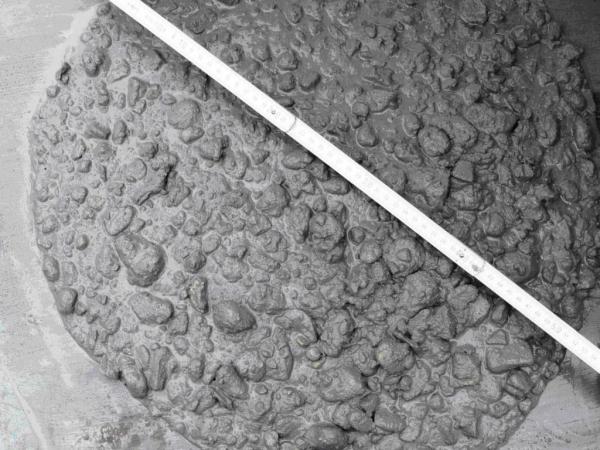

"Cement milk" is poured in such a way that it evenly envelops each granule, but does not accumulate on the surface. Such a composition should dry for at least a day, and only then you can proceed to the concrete screed.
Second way
Expanded clay is placed in a container, poured with water, and then sand and cement are added in a ratio of 3: 1. The ingredients are mixed, the mixture is poured onto the prepared surface and leveled using beacons.
If you add less water, then the mixture will be thicker, "dry", and then it should not be poured out, but spread on the floor, and then properly tamped. Such a screed will dry faster, that is, you can start finishing work earlier.
They check whether the expanded clay screed is dry in a simple way: put an ordinary glass jar on it. If it fogs up, then the screed is still wet.
Expanded clay: pros and cons
Insulating expanded clay - granules made by foaming and subsequent clay firing.
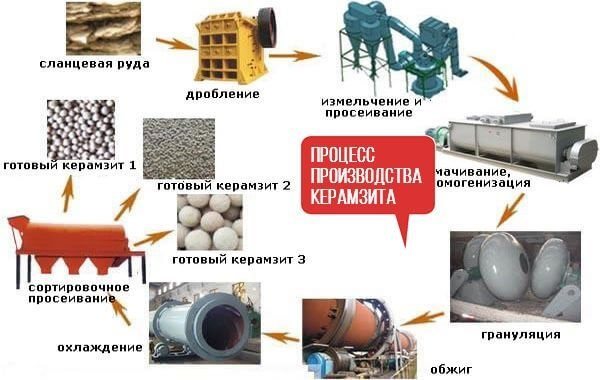

Scheme of production of expanded clay granules
It has a number of advantages when used as thermal insulation.
- Low thermal conductivity. The clay itself, from which it is made, is considered a good heat insulator. And the pores created inside, filled with air, further reduce the thermal conductivity. As a heat insulator, it is several times more effective than clay bricks and twice as good as wood.
- Light weight. An increase in the thickness of the expanded clay layer does not lead to a significant load on the floors.
- Cheapness. Despite the fact that it is inferior in thermal conductivity to many modern materials, its use saves money, losing insignificantly in the quality of insulation.
- Fire safety. This material not only does not burn, but even does not emit any toxic substances under strong heating.
- Resistant to temperature extremes. Thermal insulation properties do not change in heat or frost.
- Resistant to household chemicals and moisture. Even when wet, mold does not form on it.
- Complete environmental friendliness. Made from natural material, it is not completely harmless.
- In addition to thermal insulation properties, it is also a good sound insulator.
- Convenient to use. To work with it, you do not need to have special skills, and no special tools and devices are required. The fact that expanded clay is a bulk material excludes any requirements for observing exact dimensions when laying.
- Long term of use. It is believed to retain its properties for decades.
disadvantages
Expanded clay also has disadvantages. But their list is incomparable with the merits:
- Large volume of heat-insulating layer. To create high-quality thermal insulation, the thickness of the expanded clay cushion should be at least 10 cm. But in practice, the expanded clay layer is usually 20 - 30 cm, rarely 40 cm. In some structures of wooden floors, such insulation leads to a decrease in the space between the floor and the ceiling.
- Low moisture resistance. When a large amount of water gets on it, it absorbs it. This leads to an increase in the weight of the thermal insulation. Over time, moisture will evaporate from expanded clay granules, but this is a long process.
- Laying expanded clay, for all its simplicity, is a tedious task. Filling a thick layer, leveling with the obligatory accuracy, so as not to destroy the shell of the granules - all this takes a lot of time.
Varieties of expanded clay
The quality of expanded clay as a heater also depends on the options for its production. Depending on the size, there are three main groups of expanded clay granules. And although there are recommendations for each group for its use, usually a mixture of granules of different sizes is used in one layer.
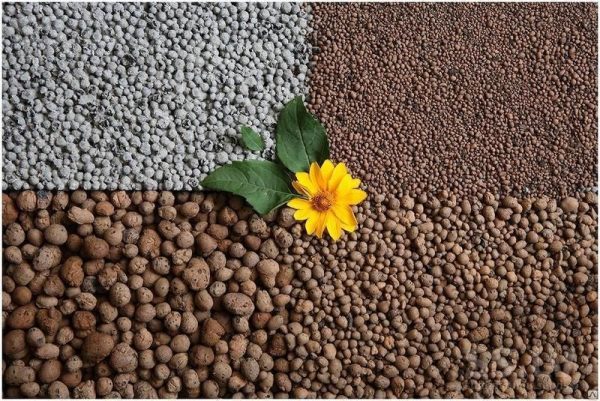

Expanded clay fractions
- Crushed stone - granules with a diameter of 20 to 40 mm. Recommended for backfilling the main layer of thermal insulation.
- Gravel - 10 to 20 mm. It is used to create thin layers.
- Sand - the smallest granules with a diameter of 5 - 10 mm. Suitable for insulating small voids in floor structures. In a mixture with coarse fractions, it allows filling the gaps between the granules. It is used to create a "wet" concrete heat-insulating screed.
In addition to size, expanded clay insulation varies in density. Commercially produced expanded clay is divided into several categories with a density of 200 to 800 kg / m3.
When to choose expanded clay
The range of heat-insulating materials on the modern market is so large that it is difficult to stop at any one. However, it is worth knowing the full range of properties of this unique material in order to understand that there is no better option than to insulate the floor with expanded clay.
The list of properties due to which this simple material is leading among competitors:
- Low thermal conductivity - the porous material contains air bubbles that provide good thermal insulation. A layer of expanded clay 10 cm surpasses a similar wooden surface in terms of thermal conductivity by 3 times, and brickwork by 10 times.
- Sound insulation - the property is in demand in apartments in multi-storey buildings, the expanded clay floor will serve as a reliable obstacle to the penetration of noise from neighbors below, at the same time preventing the propagation of sounds in the opposite direction.
- The strength of the material allows it to be used in the lower layer of the floor cake without additional supporting structures (expanded clay is produced in different strength grades from 250 to 600).
- Resistance to decay and fungi, mold (unlike wood-based materials) increases the service life of the floor, its durability.
- Chemical inertness - expanded clay is a natural material, does not emit any substances into the environment, and is itself resistant to chemicals.
- Heat resistance - quality is relevant in terms of fire safety.
- Frost resistance - expanded clay does not lose its properties at extremely low temperatures.
- Light weight - allows you to insulate the floor with expanded clay under the screed in houses where a large load on the floors is undesirable (read: "We make the floor insulated under the screed - practical advice").
- The granular fraction of the material ensures the convenience of working with it - one person who does not have construction skills can handle the filling.
- Low cost is an additional bonus for a material with a set of excellent qualities.
READ MORE: Self-leveling floor or screed: which is better?
The only drawback of expanded clay is its ability to keep moisture for a long time. This disadvantage can be easily leveled, observing the technology of flooring with expanded clay, carefully gluing the waterproofing layer.
The price range of materials in this category is as wide as their variety:
- Bituminous mastics;
- Polymer mixtures;
- Rubber hydro-barriers;
- Polyethylene film;
- Roll materials of various compositions.
Methods for creating heat-insulating layers of expanded clay
In general, the construction of expanded clay insulation differs little from the use of other materials. Expanded clay is located under the finished floor with the use of moisture-proof materials.
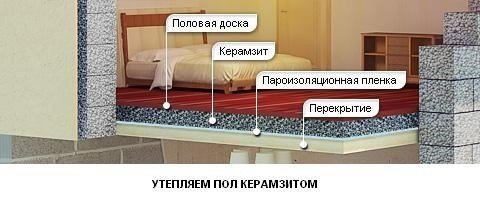

Warming with expanded clay, general principle
Depending on the location of the insulated floor (on logs laid on a foundation, on the ground or on a concrete base), the technology by which expanded clay is laid under a wooden floor also differs.
Backfill between lags
This is the easiest way to lay a claydite cushion. In this case, wooden logs serve as the basis for the floor. If they are on the foundation, then shields or sub-floor boards are attached to them. They can be hammered to the lags from below or attached to bars nailed to the lags on the side. The use of lightweight expanded clay serves as an advantage - the load on the sub-floor is low.
Further actions are as follows:
- The logs themselves and sub-floor boards are recommended to be treated with anti-rotting agents. This is especially necessary when creating new insulation in a long-built house.
- The space between the lags is lined with a waterproofing film. As its substitute, you can choose polyethylene or roofing felt. If transverse bars are installed between the lags, then each cell is covered separately.
- Expanded clay granules are poured into the prepared intervals between the logs.It is recommended to mix coarse and fine fractions of expanded clay for full volume filling.
- After backfilling, the expanded clay layer is leveled along the upper edges of the log. Lags act not only as a support, but also as an indicator of the level of the insulation backfill.
- It is advisable to tamp the leveled layer of expanded clay lightly. When tamping, you must not damage the granules, since they will absorb moisture through the cracks.
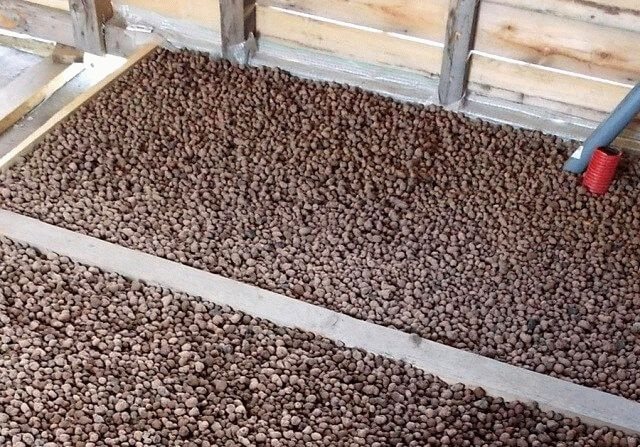

Expanded clay, covered on a wooden sub-floor along the logs
The installation of the floor along the logs can also be carried out on a concrete base as a sub-floor. In this case, the expanded clay backfill technology is no different.
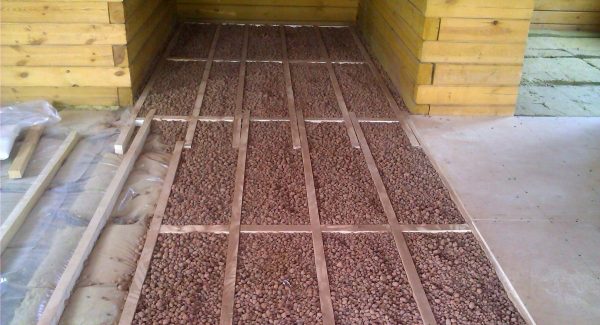

Backfilling of expanded clay on logs on a concrete base
Backfill of expanded clay for a wooden floor on the ground
Such floors can be installed in utility rooms or garages. But the expanded clay pillow is not laid out directly on the ground. The procedure is as follows:
- The top layer of the earth is removed.
- A layer of gravel is filled up. It will perform the function of waterproofing, protecting expanded clay from moisture from the ground.
- The gravel is covered with sand, which must be carefully tamped.
- A protective film is laid over the sand.
- The insulating layer of expanded clay is poured onto a sand cushion, leveled and lightly rammed.
- Further flooring depends on the wishes of the builder. You can lay the floor directly on top of expanded clay, you can fill the expanded clay layer with concrete, forming a "wet" screed. And you can use a layer of expanded clay as a rough insulation, creating another insulating level above it, on top of which to lay a finishing floor.
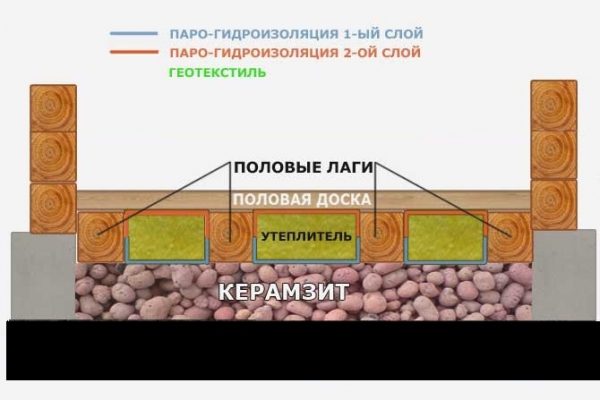

Expanded clay bedding as a subfloor on the ground
Concrete screed using expanded clay
If a concrete base is supposed to be installed under floorboards, then such a floor can be insulated by "embedding" expanded clay into a concrete screed:
- The base prepared for the screed is closed with waterproofing.
- The entire surface is covered with expanded clay. Small fractions are predominantly used.
- The expanded clay layer is leveled and compacted.
- For greater reliability, a reinforcing mesh is placed on top of the expanded clay.
- The last stage is concrete pouring.
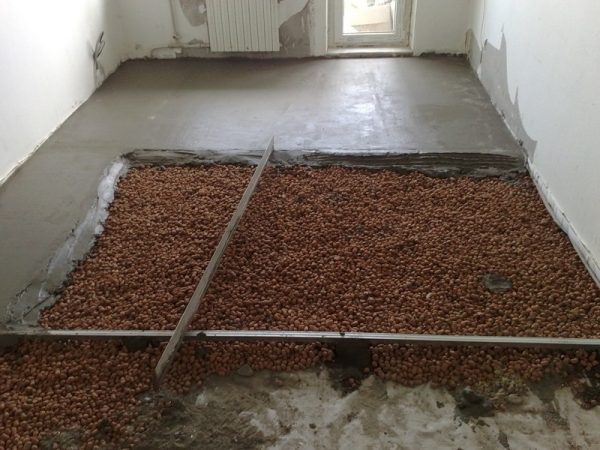

Concrete screed on expanded clay pad
Dry expanded clay screed
This method of flooring has recently become known. The preparatory part depends on the base on which it is planned to arrange the screed - on the ground, on a rough wooden floor or on a concrete slab.
The base is covered with a protective film on which expanded clay is poured. After leveling the expanded clay cushion, it is covered with sheets of plywood or gypsum fiber. Fastening sheets - with glue, or self-tapping screws.
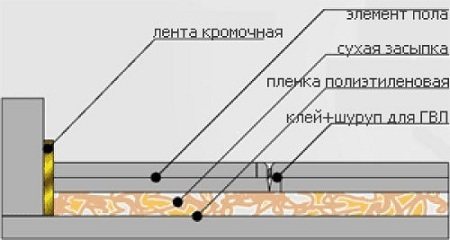

Dry screed with insulation
Final work
Any version of the construction of expanded clay insulating layer means the completion of the rough stage of flooring. The insulating layer must be covered with a hydro or vapor barrier material. And already on top of this insulation made of plywood or other sheet material, the substrate is fixed, corresponding to the selected floor covering.
With the option of a floor on logs, a wooden finishing floor can be installed directly on them, without creating a separate substrate.
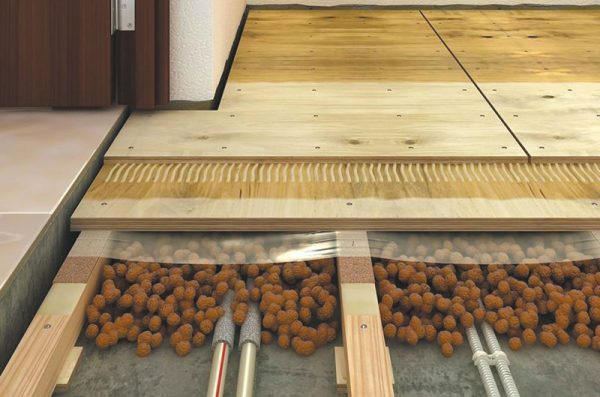

Section of a wooden floor with expanded clay insulation

